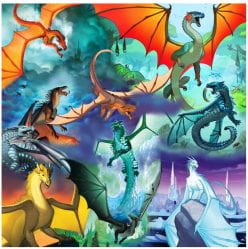Don’t Touch That, You’ll Die
By Titus Karpowich
Tom is hiking through the woods, and he sees a mushroom. He has the weird desire to eat it, so he picks it, chews it, then he swallows it. A few seconds later, his body goes limp, and he falls over. He’s alive, but he cannot call for help because he can’t feel or move anything. Welcome to the world of poisons.
That poison back there, that was a neurotoxin. They either cause spasms or paralysis. It depends if the poison causes your neurons to fire continuously, or to stop firing. A few examples of things that have neurotoxins are; lead, botulinum toxin, and tetrodotoxin (found in pufferfish). Necro toxins cause tissue to die decay. The decaying tissue must be removed, or else you get gangrene and die of blood poisoning. The bites of brown recluse spiders and puffadders have necro toxins. Certain types of bacteria that cause necrotizing fasciitis do the same thing as necro toxins. The tissue dies fast when in contact with the bacteria. Hemotoxins kill red blood cells. Hemotoxins are considered less deadly than neurotoxins. When red blood cells die, it causes hemolytic anemia. Three snakes have hemotoxins; vipers, pit vipers, and rattlesnakes. Mycotoxins can be decent or really bad. They cause hallucinations, convulsions, gangrene, and worst of all, cancer. Mycotoxins are a special type of toxin caused by fungi, mushrooms, and molds. Dioxins are a serious environmental pollutant that’s highly toxic. Cyanides happen naturally and are found in the pits of cherries, peaches, almonds, and cassava root. A few symptoms of cyanides are chest tightness, eye tearing, excitement, and difficulty breathing. Ricin is a bit like that, but with a few different symptoms and is found in castor beans and is deadly. Arsenic looks like metal and is deadly to humans, insects, bacteria, and fungi. It causes vomiting, death, diarrhea, and many other things. Sometimes, all it takes to die is a lot of something. In small amounts, poison can have beneficial properties. But in large amounts, you could die. Lots of aspirin will kill you, and four gallons of water in one shot will do the same. Be careful how much you take. Some poisons attack different things. Tobacco smoke attacks the respiratory system. It may cause immediate damage (acute poisoning), the airways swell, or over a long period of time (chronic poisoning), cancer or lung tissue scars. Many snake venoms attack the central nervous system. The central nervous system includes the brain and the spinal cord. You can either get injured or die. This is a result of paralysis of breathing muscles or convulsions. When the cardiovascular is attacked by…let’s say, sodium warfarin (rat poison), it affects the heartbeat, blood pressure, and the blood’s ability to coagulate. It also prevents blood from clotting, which causes death and lots of bleeding. When a poison, such as lye, touches skin, it destroys skin, causes ulcers, death of tissue, and scarring. Some other poisons (like poisonous parsnip sap) cause irritation, swelling, or burning. When certain chemicals, such as ammonia, touch the cornea, it will blind you. Scientists have found many ways to measure the toxicity of poisons. One way is the dose responsive curve. Aren’t there a lot of poisons? How did scientists figure out what is in which category?
People say that there’s no real way to classify poisons. There are ways to classify them, but not everyone uses the same method. A useful way to classify a poison is to see which part of the body it affects most. Like how some poisons change bone marrow, which means it can’t make blood cells…but, uh oh…when blood cells are damaged or killed, the liver can’t detoxify stuff. The liver receives more poison because lots of blood flows there. See how this one poison targeted something specific that caused a chain reaction? Another way to classify poisons is to find its source, use, and physical state. Maybe the source is from algae, who knows?
The red tide, also known as harmful algal bloom (HAB), occurs in coastal waters and is dangerous. It’s an ecological phenomenon that occurs when certain types of phytoplankton and algae overpopulate. The causes are uncertain. It might be pollution, the phosphates add nutrients to the water, which favors the growth of dinoflagellates. Dinoflagellates are a member of the Phylum Pyrrophyta, which is a part of the Protista kingdom. They’re single-celled organisms that usually have two flagella’s (tail-like structures). They go through many different life stages, they photosynthesize food, and their main mode of reproduction is asexual. Some stay dormant for years. They contain chlorophyll, and some contain reddish coloring, so when reached high concentration, the water seems red. The red tide causes a decent amount of damage to marine life. Bivalves will be affected by HABs, but fish, shrimp, and crab are kind of safe to eat. Reef fish can be infected though. The symptoms a red tide can cause are paralytic shellfish poisoning (PSP), diarrhetic shellfish poisoning (DSP), neurotoxic shellfish poisoning (NSP), which are self-explanatory, then there’s amnesic shellfish poisoning (ASP), and ciguatera fish poisoning (CFP). ASP, PSP, and CFP are life-threatening. Some red tides aren’t toxic but are still harmful. They’re known as brown tides. They don’t allow light to get through the water to the plants, so they can’t photosynthesize. If you get poisoned from a red tide, or any poison at all, you need medical treatment, as soon as possible. There are many well-developed ways to cure poisons. But you’ve got to determine the poison first, so you know what you must do. Sometimes you just have to take it easy and let the body heal itself. If you swallow a poison, you must either remove it from your digestive system, or neutralize it with charcoal. If it’s a bite or sting, use warm water and a pressure bandage, it slows the circulation to the rest of the body. When it’s a snake bite, don’t you dare cut where the bite is and suck out the poison, it doesn’t work, it just causes more pain. You should use snake antivenin. There are also many different natural defenses the body has to offer. The skin acts as a barrier, the nose filters out some particles from inhaled air, and sight or smell might keep a living creature from eating it (apparently not Tom). If a poison is swallowed, vomiting and/or diarrhea might get rid of it. Vomiting doesn’t work well, though. Exhaled air, sweat, and saliva do work, but it’s less common. Biochemical processes give protection as well. They can change the form of poison particles. But they might make something harmless toxic.
That’s the world of poisons. There are many different poisons, ways to classify them, and ways to defend or treat poisons. If you see that the water is red, tell everyone to run and skedaddle. Don’t worry, Tom’s fine. After about eight hours of lying limp on the ground he was able to move.
Works Cited
“Poison.” Britannica School, Encyclopædia Britannica, 10 Mar. 2023. school.eb.com/levels/middle/article/poison/276482. Accessed 28 Apr. 2023.
“Poisons and Toxins.” UXL Encyclopedia of Science, edited by Amy Hackney Blackwell and Elizabeth Manar, 3rd ed., UXL, 2015. Gale In Context: Middle School, link.gale.com/apps/doc/CV2644300769/MSIC?u=ko_k12pr_d65&sid=bookmark-MSIC&xid=3fb39324. Accessed 28 Apr. 2023 (Don’t know why it won’t work.)
“Red tide.” Britannica School, Encyclopædia Britannica, 10 Mar. 2023. school.eb.com/levels/middle/article/red-tide/313166. Accessed 28 Apr. 2023

 If I was forced to spend the rest of my life in a library, a museum or a zoo, I would choose the zoo. Why, may you ask? Well, that’s what I’m going to write about.
If I was forced to spend the rest of my life in a library, a museum or a zoo, I would choose the zoo. Why, may you ask? Well, that’s what I’m going to write about.

 I love skiing. Do you? Anyways, if you’re wondering what kind of skiing I do it’s both downhill and cross-country skiing.
I love skiing. Do you? Anyways, if you’re wondering what kind of skiing I do it’s both downhill and cross-country skiing. Sledding is my favourite winter activity. Sledding is really fun, and surprisingly exhausting. I’ve went sledding with my friends at the Winchester hill once or twice, and with my family a bunch of times. You have to agree when I say that sledding is a must when there’s time and snow. I also do skiing, but that is a different topic. Maybe later. Ooooooooh! There was this one time when I was 9 or 10 and I went down this one side of the hill with my brother, who was 8 or 9 at he time, and it was a bit icy and we crashed into a tree. Well, we were in different trees but I smashed my back in a sitting position. But my unlucky brother broke tiny bone’s in his ankle and had to go to the doctor’s office. That’s all I got to say about sledding.
Sledding is my favourite winter activity. Sledding is really fun, and surprisingly exhausting. I’ve went sledding with my friends at the Winchester hill once or twice, and with my family a bunch of times. You have to agree when I say that sledding is a must when there’s time and snow. I also do skiing, but that is a different topic. Maybe later. Ooooooooh! There was this one time when I was 9 or 10 and I went down this one side of the hill with my brother, who was 8 or 9 at he time, and it was a bit icy and we crashed into a tree. Well, we were in different trees but I smashed my back in a sitting position. But my unlucky brother broke tiny bone’s in his ankle and had to go to the doctor’s office. That’s all I got to say about sledding. Today I’m writing about the rules of baseball. Before I tell you about baseball I’m going to say I don’t play baseball. So, yeah, there’s that. But I do know the rules, mostly.
Today I’m writing about the rules of baseball. Before I tell you about baseball I’m going to say I don’t play baseball. So, yeah, there’s that. But I do know the rules, mostly.